Walmart tried to make sustainability affordable. Here's what happened
- Written by Andrew Spicer, Associate Professor of International Business, University of South Carolina
What a difference the birth of a granddaughter can make.
For Lee Scott, who ran Walmart from 2000 to 2009, the arrival of his granddaughter not only convinced[1] him the threat of global warming was real but set him on a course that altered the very DNA of the world’s largest retailer[2]. He decided he wanted to use its size and resources to make the world an “even better place for all of us,” changing the way millions shop in the process.
In 2005, midway through his tenure, he challenged his employees: “What would it take for Walmart to be that company, at our best, all the time?”
The answer became Walmart’s sustainability program[3], an ambitious effort to figure out how to get its budget-conscious customers to buy more sustainable products. Of course, it was more than Scott’s granddaughter that pushed the retailer in this direction. A dismal perception[4] among the public as well as a stagnant stock price[5] also played roles in prodding Scott and other Walmart officials to take the company in a more environmentally aware direction.
We spent[6] five years[7] studying the program – speaking with Walmart’s sustainability leaders, its suppliers and others who have a stake in the company’s activities such as environmental groups and farmers. Our findings highlight both the promises and perils of what one Walmart executive optimistically termed the “democratization of sustainability.”
Glaciers, landfills and shopping bags
During our extensive research into the implementation of Walmart’s sustainability program, we found many executives from the CEO on down who were passionate about making the company more environmentally friendly. Before the retailer even began its program, corporate executives traversed the globe to better understand what was at stake.
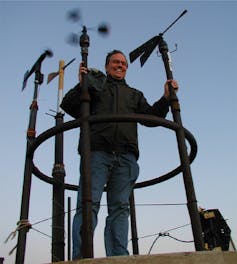 Lee Scott visited one of the observatories atop Mt. Washington in New Hampshire as part of his climate change fact finding mission in 2005.
Jib Ellison, Author provided (No reuse)
Lee Scott visited one of the observatories atop Mt. Washington in New Hampshire as part of his climate change fact finding mission in 2005.
Jib Ellison, Author provided (No reuse)
We were told stories of Scott’s summer 2005 trip to the top of Mount Washington in New Hampshire, where scientists take measurements[8] of the ice and the wind to measure the effects of climate change and air pollution. There he met with Environmental Defense Fund President Fred Krupp[9] and some of the scientists to discuss the company’s environmental impact and what it could be doing differently. On that same trip, he also met with maple syrup farmers who explained how climate change was affecting their harvests.
Other company leaders made trips to parched cotton fields, landfills covered with Walmart shopping bags and melting Arctic glaciers, all with the aim of gaining a deeper understanding of sustainability and engaging with environmental groups, journalists and critics.
But it still wasn’t clear where all this was going until August of that year, when Hurricane Katrina[10] hit New Orleans, causing extensive human suffering and property damage along the coast.
Walmart, in an unusual move, gave local managers wide discretion[11] in helping communities respond and, along with a few other large retailers, worked hard to get needed supplies to the area. In the context of widely reported government failures[12] during the crisis, Walmart received praise[13] for its actions – a far cry from the usual criticism Scott received from social and political activists.
After Katrina, Scott had an epiphany, which culminated in that speech[14] he made in October 2005 near Walmart’s headquarters in Bentonville, Arkansas, during which he announced the project:
“What if we used our size and resources to make this country and this earth an even better place for all of us: customers, associates, our children and generations unborn?”
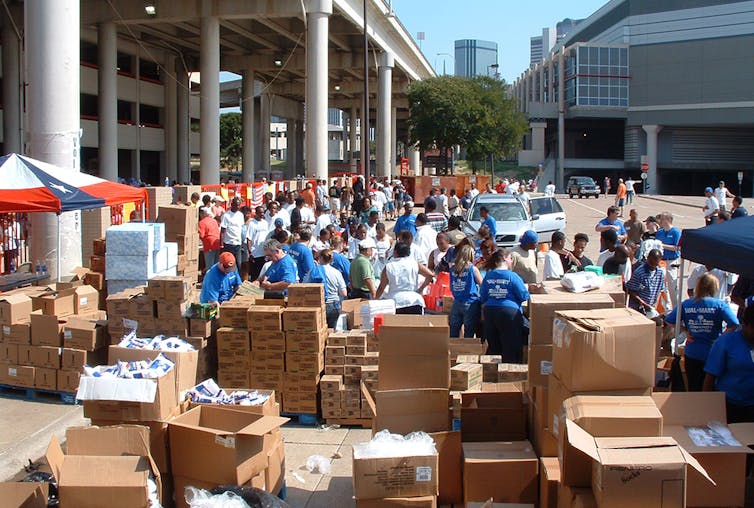 Walmart won praise for its efforts to help ferry supplies to New Orleans after Hurricane Katrina in 2005.
Walmart
Walmart won praise for its efforts to help ferry supplies to New Orleans after Hurricane Katrina in 2005.
Walmart
Seeking sustainability
In the speech, Scott laid out Walmart’s sustainability vision to Walmart employees and suppliers. He called for reducing waste, using more renewable energy and selling products that “sustained people and the environment.”
In a way, these goals sounded easy. Simply cut down on waste, become more efficient, convince its legions of suppliers to make more sustainable products and sell them at its “low, low prices.” Sustainability goes up, costs go down, everybody wins. But as Scott and his successors learned, this was easier said than done.
Some aspects were relatively straightforward. The company’s efforts to operate more efficiently produced significant environmental value[15] – and helped its bottom line[16]. The efficiency of its fleet of trucks doubled within a decade. Walmart has now converted 28 percent[17] of the energy sources powering its stores and operations globally to renewables.
And last year, the company diverted 78 percent[18] of its global waste from landfills, instead finding ways to recycle, reuse or even sell the garbage. Its goal is to eventually get to 50 percent renewables and zero waste in Canada, Japan, the U.K. and U.S. by 2025.
Selling products that “sustained people and the environment” was harder. By 2008, its was clear that progress was not being made as fast as the company had expected.
Walmart had a challenging job. While the market[19] for sustainable products is large and growing, it has primarily catered to people with a lot of disposable income who can afford[20] to pay the “goodness” premium[21] for things like Toyota Priuses and organic foods.
What about the majority of consumers who usually see the high price of sustainability as a barrier[22]? Are sustainable products a luxury good only attainable by the well off?
The questions and challenges of selling sustainable products escalated over time. What is a sustainable product? How could it be measured effectively and efficiently? And how could this information create value for the company and customers? Would people be willing to pay for it if it was impossible to keep the costs down?
Two interconnected challenges it faced are particularly illuminating: the lack of a sustainability standard and how to convince suppliers and customers to go along.
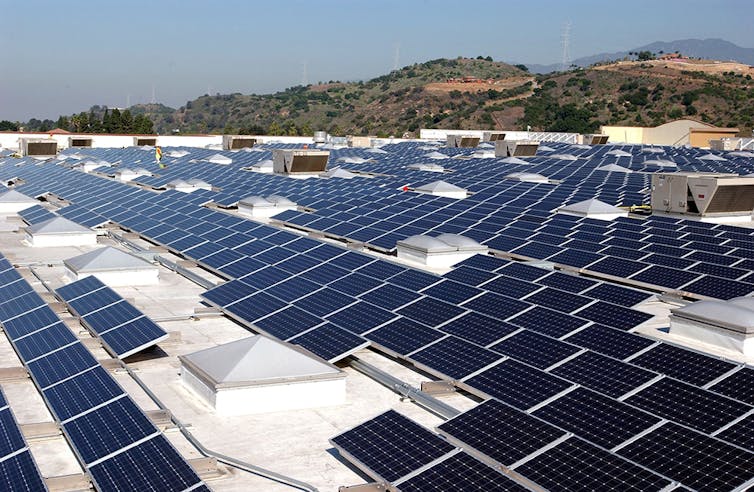 Walmart aims to eventually get 100 percent of its power from renewable sources, like these solar panels on a Sam’s Club in Glendora, Calif.
Walmart
Walmart aims to eventually get 100 percent of its power from renewable sources, like these solar panels on a Sam’s Club in Glendora, Calif.
Walmart
What’s ‘sustainable’ anyway?
Walmart leaders quickly learned that the absence of a credible sustainability standard hampered their ability to market new products.
Back then, marketing products as “sustainable” was anything goes. While a few marketing attributes, like “organic,” are verified[23] by the U.S. Department of Agriculture, for the most part companies were free to call their products “sustainable,” “natural” or “good for you,” regardless of whether it was true or not.
The need for a standard crystallized when Walmart asked suppliers for proposals for a 2008 Earth Day promotion[24]. It wanted to specifically promote products that were sustainable. Suppliers responded with such a vast range of claims that Walmart managers could not figure out which products to include. Examples of traits that made a product “sustainable” ranged from having “reduced” packaging material – though there was no gauge as to what it was reduced from – to the use of non-toxic ingredients or the product’s overall recyclability.
A subsequent promotion of Campbell’s soup with a green “Earth Day” label (instead of its customary red one) generated external criticism and accusations of “greenwashing.” That is, some bloggers[25] claimed sustainability at Walmart simply meant taking existing products and putting green labels on them.
Lessons like these led Walmart to seek a way of defining what sustainable means for all its products – a mammoth scale given that the company had over 60,000 direct suppliers and a single store could sell about 142,000 products[26]. So, in 2009, the company helped establish the Sustainability Consortium[27], a collaboration of retailers, suppliers, universities, environmental groups and others to create a data-driven index of sustainability.
The consortium would eventually produce a sustainability “toolkit” with key performance indicators and guidance for achieving sustainability at the product category level whether these be laundry care products, computers or beer.
Such indicators could then be used by consortium members in communications with their suppliers, typically in a sustainability scorecard that the supplier would complete. For instance, a manufacturer might be asked if it had plans for reducing harmful emissions – and if it didn’t, the thinking initially went, this type of information could eventually be passed on to consumers who could then make their own judgments.
The problem was, relying on customers didn’t work.
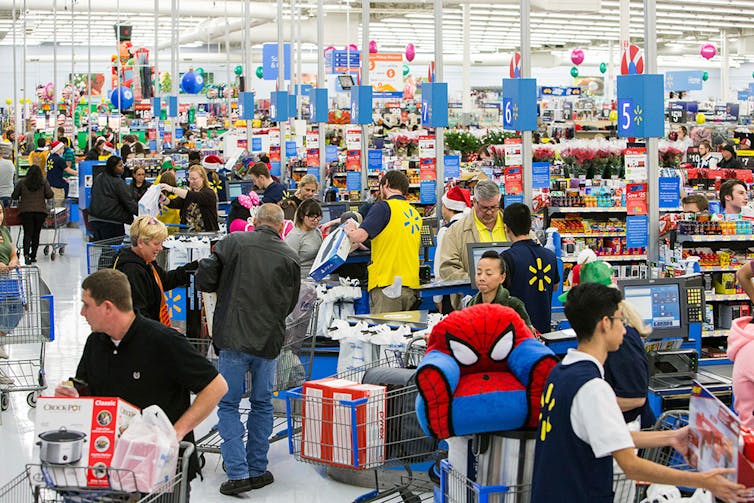 Getting its budget-conscious customers to choose sustainable products was one of Walmart’s biggest challenges.
AP Images for Walmart/Gunnar Rathbun
Getting its budget-conscious customers to choose sustainable products was one of Walmart’s biggest challenges.
AP Images for Walmart/Gunnar Rathbun
Focusing on suppliers – not consumers
Most corporate efforts to become more sustainable are based on the premise that consumers are willing[28] to pay more for eggs that are organic or coffee that is sustainably sourced.
This posed a dilemma for Walmart since its margins are so thin and most of its customers shop there for the ultra-low prices. How could they be convinced, en masse, to pay a bit more because something is tagged as sustainable? And what would be the best way to let them know a particular product was more sustainable than another? Company leaders believed, based on internal surveys, that although its customers desired (or would in the future desire) more sustainable products, many did not have the means or desire to pay extra.
And while Walmart’s implementation of sustainability metrics into its supplier scorecards gave it insight into supplier practices, they did not provide detailed, verifiable information required for a customer-facing label.
This led Walmart to focus less on consumers and more on suppliers. If it could just make sure its products were more sustainable or at least that it was able to offer more options – without a meaningful increase in price – it could go a long way toward achieving its goals. And consumers wouldn’t even realize they’re helping make the world a better place.
Walmart’s merchants were ready to listen. The supplier scorecards that started rolling in 2012 helped Walmart identify inefficiencies in its supplies’ own supply chains, just as the retailer had found in its own operations years earlier. Walmart used them to push suppliers to seek out similar low-cost innovations in their operations – so they could become more sustainable without altering product price tags – and aligned 5 percent of its employees’ performance goals on sustainability improvements, thus incentivizing buyers to ask about, and suppliers to report on, sustainability metrics.
Early indications are that Walmart’s supplier-focused product sustainability strategy has been influential. A 2014 study[29] by sustainability consultancy Pure Strategies surveyed a broad range of 100 companies such as Timberland, General Mills and Coca-Cola to better understand what it takes to operate sustainably. It found that Walmart was the top-cited retailer driving suppliers’ investments in product sustainability, with 79 percent identifying the retailer as influential.
It’s ‘complicated’
Many of the primary lessons that Walmart has learned so far relate to an emergent understanding of the complexity of selling low-cost sustainable products.
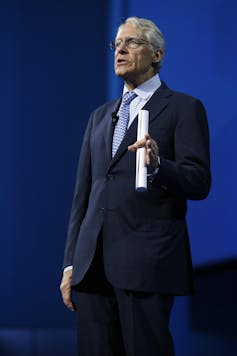 Walmart Chairman Rob Walton.‘
AP Photo/Gareth Patterson[30]
Walmart Chairman Rob Walton.‘
AP Photo/Gareth Patterson[30]
Commenting about the difficulty developing its sustainability index quickly, Rob Walton, Walmart chairman and son of the founder, told a panel[31] in 2012: “But good gosh, this is really complicated stuff, and it’s giving our buyers information to inform decisions and compare products. It will be a great day when we can give consumers that information.”
Walmart’s efforts showed that balancing cost and sustainability is possible but difficult to implement. For companies, labeling a low-cost product as “sustainable” makes it harder to justify charging a higher price for a similar good that bears that label. And retailers would prefer not to waste limited shelf space providing those options.
Customers may prefer[32] sustainable practices yet be unable to pay the premium, even when it’s very little. So, while Walmart can push in this direction, it probably cannot create a mass market for low-cost sustainable products on its own. The retailer and others who wish to develop such a market will likely continue to struggle with what counts as “sustainable enough” for price-conscious customers.
Until that question is answered, sustainable products are likely to remain “luxury” goods that fail to penetrate into the mainstream.
But if we care for the next generation, as Lee Scott did when he decided Walmart was going green, Walmart’s goal of bringing greater scale and scope to the typically niche market of sustainability is a vital one.
“As you become a grandparent,” Scott told a journalist[33] in 2006, “you just become more thoughtful about what will the world look like that she inherits.”
References
- ^ convinced (books.google.com)
- ^ world’s largest retailer (www.forbes.com)
- ^ sustainability program (corporate.walmart.com)
- ^ dismal perception (topdocumentaryfilms.com)
- ^ stagnant stock price (finance.yahoo.com)
- ^ spent (www.researchgate.net)
- ^ five years (doi.org)
- ^ scientists take measurements (www.mountwashington.org)
- ^ Fred Krupp (www.huffingtonpost.com)
- ^ Hurricane Katrina (theconversation.com)
- ^ gave local managers wide discretion (www.washingtonpost.com)
- ^ widely reported government failures (theconversation.com)
- ^ received praise (www.huffingtonpost.com)
- ^ speech (corporate.walmart.com)
- ^ significant environmental value (corporate.walmart.com)
- ^ bottom line (www.environmentalleader.com)
- ^ has now converted 28 percent (corporate.walmart.com)
- ^ company diverted 78 percent (corporate.walmart.com)
- ^ market (www.unilever.com)
- ^ who can afford (www.nielsen.com)
- ^ premium (www.luxurysociety.com)
- ^ high price of sustainability as a barrier (www.sustainabilityconsortium.org)
- ^ verified (www.usda.gov)
- ^ 2008 Earth Day promotion (corporate.walmart.com)
- ^ bloggers (thewashcycle.wordpress.com)
- ^ 142,000 products (corporate.walmart.com)
- ^ Sustainability Consortium (www.sustainabilityconsortium.org)
- ^ consumers are willing (ashtonmanufacturing.com.au)
- ^ study (purestrategies.com)
- ^ AP Photo/Gareth Patterson (www.apimages.com)
- ^ told a panel (fortune.com)
- ^ prefer (www.unilever.com)
- ^ told a journalist (grist.org)
Authors: Andrew Spicer, Associate Professor of International Business, University of South Carolina
Read more http://theconversation.com/walmart-tried-to-make-sustainability-affordable-heres-what-happened-76771

